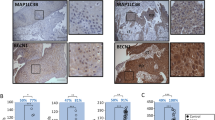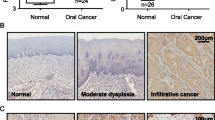Abstract
Dyregulation of autophagy has been reported in various human cancers including oral squamous cell carcinoma (OSCC). The objective of this study was to link expression of autophagy-related 16-like 1 (ATG16L1), a protein essential for autophagosome formation, to clinical outcome in a cohort of 90 OSCC patients. Expression level of ATG16L1 was assessed by immunohistochemistry and an immunoreactivity score (IRS), ranging from 0 to 9, was assigned to each case. The results were correlated with clinicopathological parameters and outcome of patients. Twenty-seven patients (30 %) exhibited ATG16L1 overexpression as indicated by an IRS of 9. Overexpression of ATG16L1 was significantly associated with disease stage (p = 0.001), size (p = 0.031) of the tumor, lymph node metastasis (p = 0.004), and histological grade (p = 0.038). ATG16L1 overexpression significantly affected the overall survival (p = 0.020) and time to recurrence (p = 0.031) of OSCC patients in Kaplan-Meier analysis. The present study suggested that ATG16L1 may be used as a biomarker for selecting OSCC patients with a more aggressive phenotype.


Similar content being viewed by others
Abbreviations
- OSCC:
-
Oral squamous cell carcinoma
- ATG16L1:
-
Autophagy-related 16-like 1
- IRS:
-
Immunoreactivity score
- ROC:
-
Receiver operating characteristics
- OS:
-
Overall survival
- TTR:
-
Time to recurrence
References
Jemal A, Bray F, Center MM, Ferlay J, Ward E, Forman D (2011) Global cancer statistics. CA Cancer J Clin 61(2):69–90. doi:10.3322/caac.20107
Ranadive KJ, Ranadive SN, Shivapurkar NM, Gothoskar SV (1979) Betel quid chewing and oral cancer: experimental studies on hamsters. International Journal of Cancer Journal International du Cancer 24(6):835–843
Mashberg A, Boffetta P, Winkelman R, Garfinkel L (1993) Tobacco smoking, alcohol drinking, and cancer of the oral cavity and oropharynx among U.S. veterans. Cancer 72(4):1369–1375
Pindborg JJ, Reibel J, Roed-Peterson B, Mehta FS (1980) Tobacco-induced changes in oral leukoplakic epithelium. Cancer 45(9):2330–2336
Paterson IC, Eveson JW, Prime SS (1996) Molecular changes in oral cancer may reflect aetiology and ethnic origin. Eur J Cancer B Oral Oncol 32B(3):150–153
Park JY, Muscat JE, Ren Q, Schantz SP, Harwick RD, Stern JC, Pike V, Richie JP Jr, Lazarus P (1997) CYP1A1 and GSTM1 polymorphisms and oral cancer risk. Cancer Epidemiol Biomarkers Prev: a publication of the American Association for Cancer Research, cosponsored by the American Society of Preventive Oncology 6(10):791–797
Elwood JM, Pearson JC, Skippen DH, Jackson SM (1984) Alcohol, smoking, social and occupational factors in the aetiology of cancer of the oral cavity, pharynx and larynx. International Journal of Cancer Journal International du Cancer 34(5):603–612
Klionsky DJ, Emr SD (2000) Autophagy as a regulated pathway of cellular degradation. Science 290(5497):1717–1721
Mizushima N (2007) Autophagy: process and function. Genes Dev 21(22):2861–2873. doi:10.1101/gad.1599207
Mathew R, Karantza-Wadsworth V, White E (2007) Role of autophagy in cancer. Nat Rev Cancer 7(12):961–967. doi:10.1038/nrc2254
Mizushima N, Noda T, Ohsumi Y (1999) Apg16p is required for the function of the Apg12p-Apg5p conjugate in the yeast autophagy pathway. EMBO J 18(14):3888–3896. doi:10.1093/emboj/18.14.3888
Nomura H, Uzawa K, Yamano Y, Fushimi K, Ishigami T, Kouzu Y, Koike H, Siiba M, Bukawa H, Yokoe H, Kubosawa H, Tanzawa H (2009) Overexpression and altered subcellular localization of autophagy-related 16-like 1 in human oral squamous-cell carcinoma: correlation with lymphovascular invasion and lymph-node metastasis. Hum Pathol 40(1):83–91. doi:10.1016/j.humpath.2008.06.018
Hippert MM, O’Toole PS, Thorburn A (2006) Autophagy in cancer: good, bad, or both? Cancer Res 66(19):9349–9351. doi:10.1158/0008-5472.CAN-06-1597
Kimmelman AC (2011) The dynamic nature of autophagy in cancer. Genes Dev 25(19):1999–2010. doi:10.1101/gad.17558811
Tang JY, Hsi E, Huang YC, Hsu NC, Chu PY, Chai CY (2013) High LC3 expression correlates with poor survival in patients with oral squamous cell carcinoma. Hum Pathol 44(11):2558–2562. doi:10.1016/j.humpath.2013.06.017
Wu WK, Coffelt SB, Cho CH, Wang XJ, Lee CW, Chan FK, Yu J, Sung JJ (2012) The autophagic paradox in cancer therapy. Oncogene 31(8):939–953. doi:10.1038/onc.2011.295
Conflict of Interest
We declare that we have no conflict of interest.
Author information
Authors and Affiliations
Corresponding authors
Rights and permissions
About this article
Cite this article
Tang, JY., Hsi, E., Huang, YC. et al. Overexpression of Autophagy-Related 16-Like 1 in Patients with Oral Squamous Cell Carcinoma. Pathol. Oncol. Res. 21, 301–305 (2015). https://doi.org/10.1007/s12253-014-9821-7
Received:
Accepted:
Published:
Issue Date:
DOI: https://doi.org/10.1007/s12253-014-9821-7




